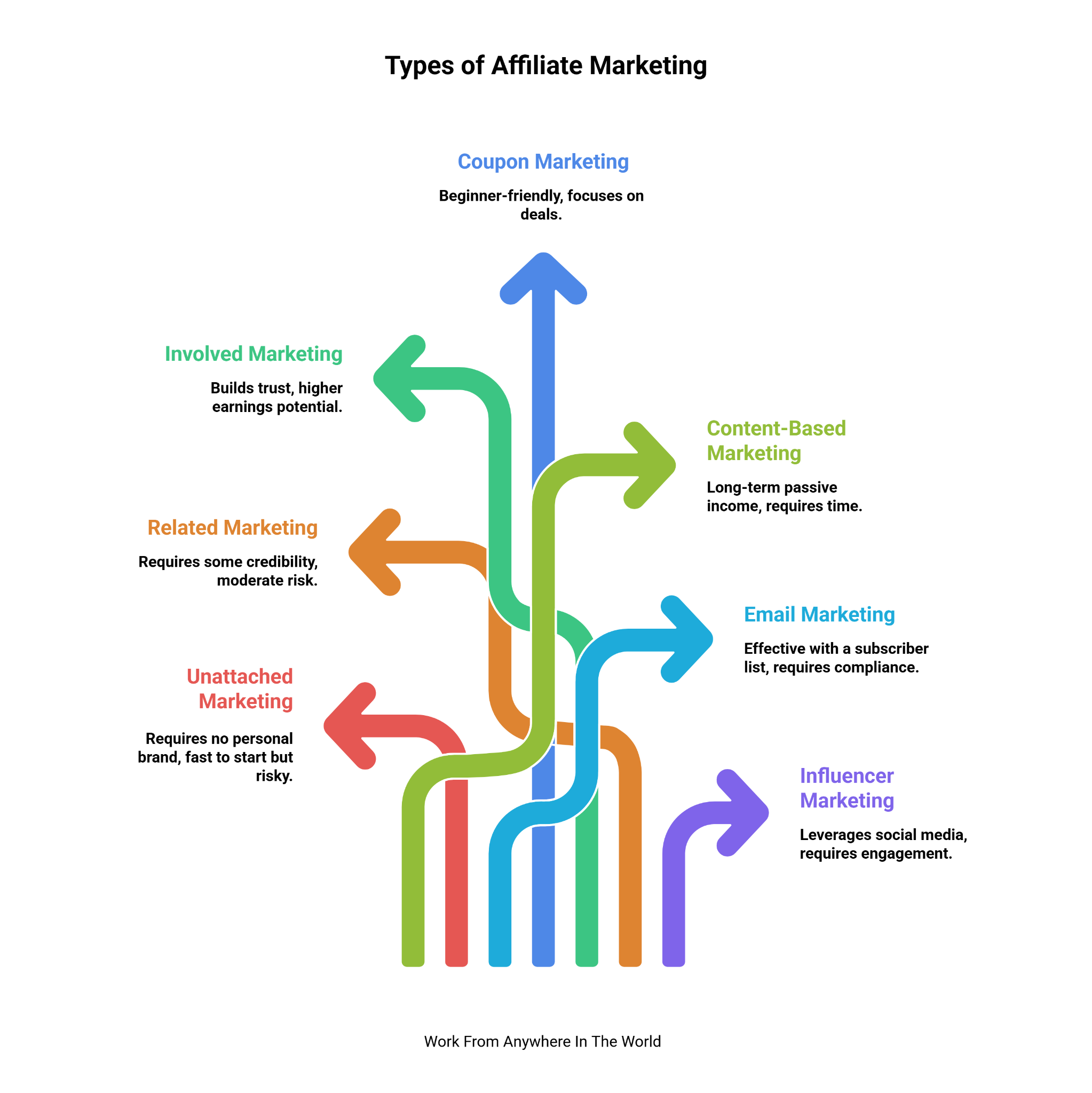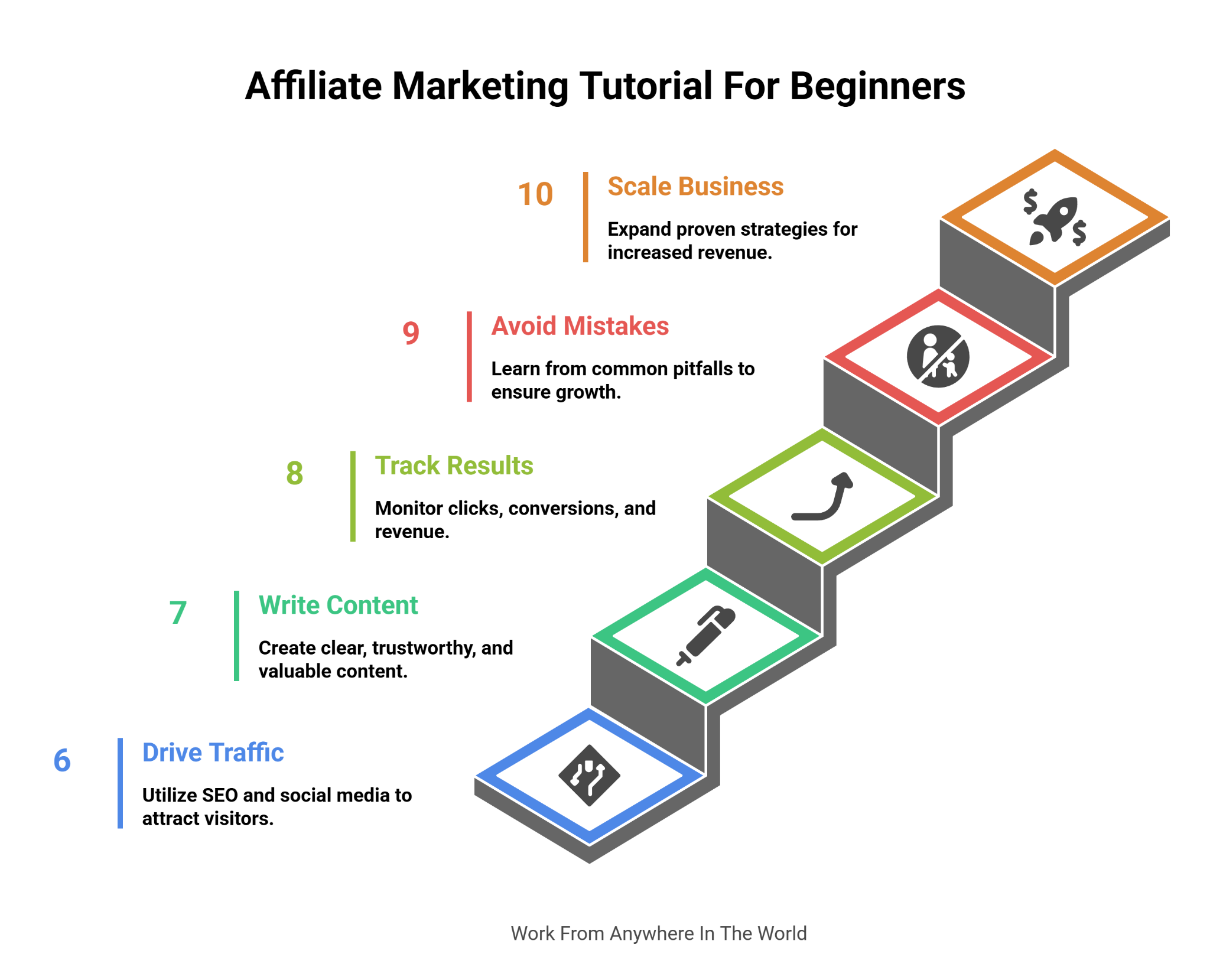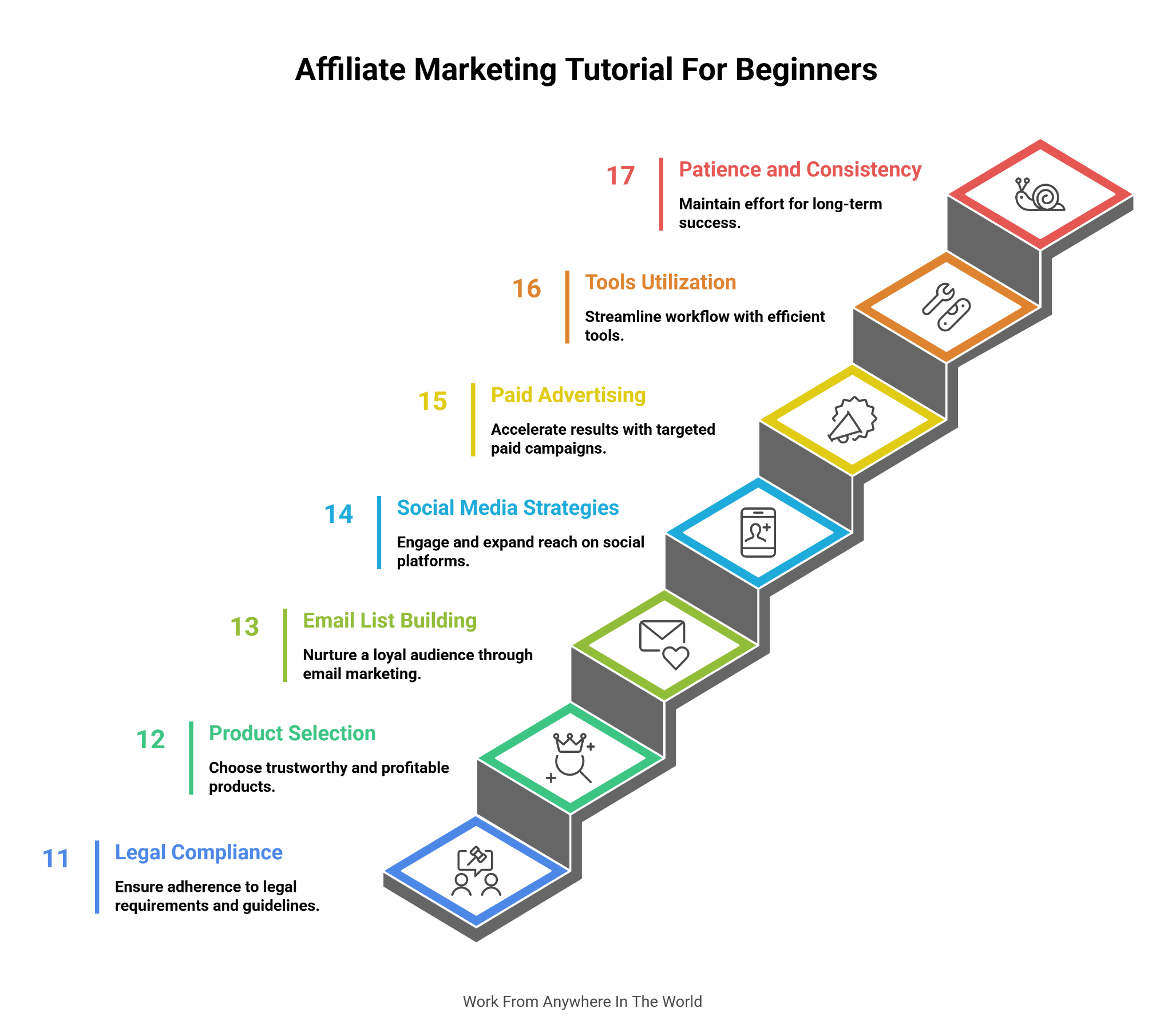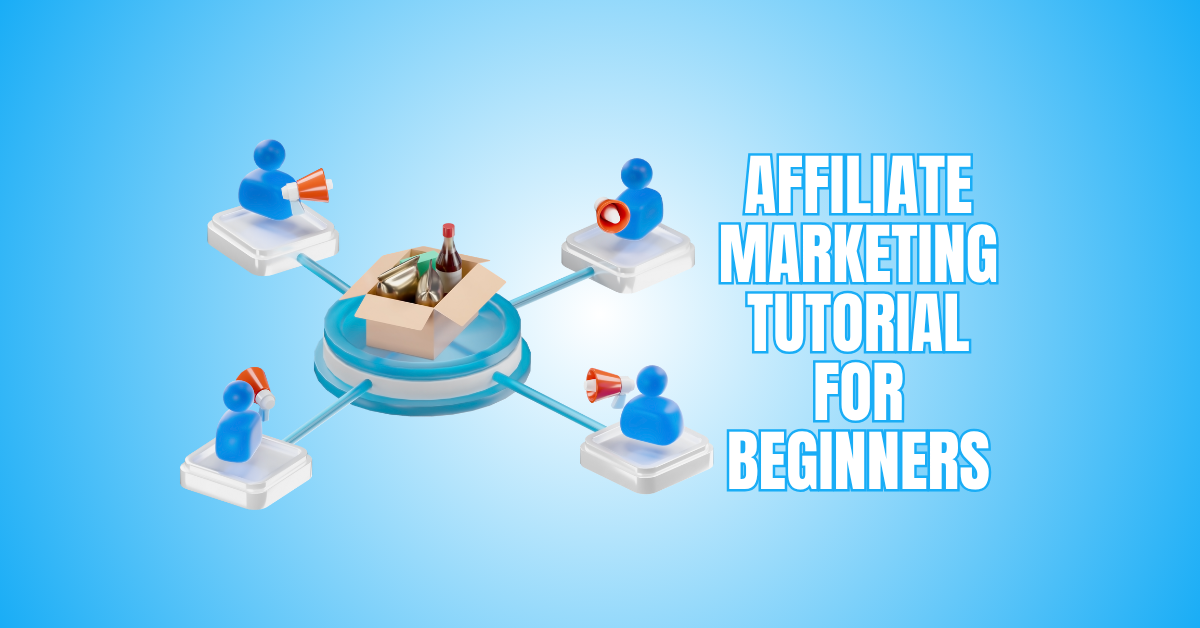Affiliate Marketing Tutorial For Beginners
Welcome to this Affiliate Marketing Tutorial for Beginners. If your goal is to build a reliable online income stream, this guide will show you how.
From choosing the best affiliate programs to promoting goods that truly convert, you'll discover the essential steps to getting off to a great start.
Whether you’re new to affiliate marketing or improving your approach, you’ll find clear strategies, expert insights, and practical techniques to help you grow your earnings and succeed in the digital marketplace.
What Is Affiliate Marketing?
Affiliate marketing is a performance-based business. You earn money when someone acts on your promotion. Usually, this means purchasing through your affiliate link. Think of it as being a salesperson online.
The difference? You don’t handle the product or customer service. You just focus on recommending products you trust. Companies benefit by getting sales without paying up front, and affiliates benefit by earning commissions.
How Affiliate Marketing Works
The process is simple but powerful. First, you join an affiliate program. Next, you get a unique affiliate link. Then, you share that link on your blog, social media, or email list. Finally, when someone clicks and buys, you earn a commission.
That’s the whole cycle. The better you get at driving traffic, the more money you make. It’s a scalable business. Once your links are out there, they can keep earning for months or even years.
Types of Affiliate Marketing
Affiliate marketing offers multiple ways to earn online. Understanding the different types helps beginners choose the best approach, maximize earnings, and match strategies with their skills and audience.
1. Unattached Affiliate Marketing
Unattached affiliate marketing requires no personal brand, website, or audience. You promote a product solely through paid ads or external channels.
Since you aren’t personally involved with the product, your earnings depend purely on traffic and conversions. Commissions vary widely, often 5–50% per sale for digital or physical products.
This type is ideal for people who want a hands-off approach and can invest in paid advertising. It’s fast to start, but risky if ad campaigns fail. Beginners with a budget for testing ads can experiment here.
2. Related Affiliate Marketing
Marketing products that are related to your topic but that you haven't used yourself is known as related affiliate marketing. For example, a fitness blogger may promote protein supplements they haven’t tried.
Content like tutorials, listicles, and guides drives clicks. Commissions vary for each program, ranging from 5 to 50%. It’s suitable for people who already have a niche audience or plan to build one.
It requires some credibility and quality content to convince your audience. Earnings grow as your platform gains trust and traffic. It balances effort with moderate risk and potential for passive income.
3. Involved Affiliate Marketing
An involved affiliate marketing is the most effective type. You personally use the product and create authentic content like reviews, tutorials, or demos. This builds trust and increases conversion rates.
Commissions vary from 5–70%, sometimes higher for digital products or subscriptions. It’s perfect for individuals who want long-term income and are willing to engage with their audience.
Requires more time and effort but has higher earnings potential. Ideal for bloggers, YouTubers, or social media influencers who want to recommend products while earning substantial commissions over time.
4. Coupon Or Deal Affiliate Marketing
Coupon affiliate marketing focuses on sharing discounts, promo codes, or deals. Audiences are drawn to savings, and conversions tend to be higher.
Affiliates can earn anywhere from 5–20% per sale, sometimes flat fees for specific actions. It works well for social media pages, deal websites, or email lists.
This type is suitable for people who can consistently find and share deals. Minimal content creation is required, making it beginner-friendly.
Success depends on attracting bargain-seeking audiences. With consistent traffic, coupon affiliates can generate steady, predictable earnings.
5. Content-Based Affiliate Marketing
Content-based affiliate marketing revolves around creating value-rich content such as blogs, videos, and guides. You incorporate affiliate links naturally within helpful material.
Potential earnings are broad, often 5–70% per sale, depending on the product. It’s ideal for writers, bloggers, and video creators who enjoy educating or entertaining audiences.
Requires time to build credibility and traffic, but offers long-term passive income. Works best in niches with high-demand products. Once content ranks in search engines or social platforms, it keeps generating commissions for months or years.
6. Email Marketing Affiliate
Email marketing affiliates use newsletters to promote products to a subscribed audience. They craft valuable emails with affiliate links or recommendations. Earnings vary by program: 5–50% per sale, plus recurring commissions if promoting subscriptions.
This type suits people who are comfortable writing and have or can build an email list. It’s highly effective because subscribers trust your recommendations.
Requires compliance with anti-spam laws and careful content planning. Successful email affiliates can earn consistent monthly income with minimal ongoing effort, making it ideal for long-term passive revenue.
7. Influencer Or Social Media Affiliate Marketing
Influencer affiliate marketing leverages social media followers to promote products. Posts, reels, or stories include affiliate links or discount codes.
Earnings vary by program, from $5 to $500+ per sale, depending on your niche and audience size. Best for people with large or engaged social media followings.
It’s ideal for Instagram, TikTok, or YouTube influencers who can integrate promotions naturally. Requires content creation skills and consistency.
Engagement is critical; higher engagement leads to better conversions. Influencer affiliate marketing can become a full-time income source with a loyal, trusting audience.

Affiliate Marketing Tutorial For Beginners
1. Choosing A Profitable Niche
Start by brainstorming your interests and expertise. Use Google Trends to check popularity over time and Amazon Best Sellers to find in-demand products.
For keyword validation, tools like Ahrefs or SEMrush show search volume and competition. Narrow broad niches (e.g., “fitness”) into sub-niches (“yoga for beginners at home”).
This ensures a targeted audience and higher conversions. Validate profitability by checking affiliate network listings to confirm good commissions.
Choosing a niche backed by demand, low competition, and relevant products helps you build an audience faster and sets a strong foundation for long-term success.
2. Finding Affiliate Programs
This step is crucial in an affiliate marketing tutorial for beginners, showing how to find, evaluate, and organize programs for consistent earnings.
These platforms let you filter merchants, review commission rates, cookie durations, and payment schedules. Use Google with “[Brand] affiliate program” to locate direct brand offers.
Keep a spreadsheet (Google Sheets works well) to compare terms and track applications. Some programs offer dashboards, creative banners, and affiliate managers for support.
Tools like ThirstyAffiliates help organize links once you’re approved. Choosing reliable programs ensures steady payments, access to marketing materials, and better tracking to maximize your affiliate marketing efforts.
Wealthy Affiliate – Mini Review (2025)
If you’ve ever thought about turning your blog, passion, or niche into an online business,
Wealthy Affiliate (WA) is one of the most beginner-friendly platforms I’ve used.
It combines step-by-step training, website hosting, SEO research tools,
and an active community all in one place.
What I like most: you can start free (no credit card needed),
explore lessons, test the tools, and connect with other entrepreneurs
before upgrading. WA isn’t a “get rich quick” scheme — it’s a platform where success comes
from consistent effort and applying what you learn.
3. Setting Up Your Platform
For blogs, use WordPress with a hosting service like Bluehost or SiteGround. Install Yoast SEO for optimization and Pretty Links to manage affiliate URLs.
Create essential pages: About, Contact, Privacy Policy, and Affiliate Disclosure. If you prefer video, YouTube is free and integrates with affiliate promotions.
On social platforms like Instagram or TikTok, use Linktree or Carrd for multiple link management. Email marketers can start with ConvertKit or Mailchimp.
Each tool helps build trust, deliver content, and share affiliate links effectively. Choose a platform matching your style and scale gradually as your audience grows.
4. Creating Valuable Content
Content drives clicks and conversions. Identify audience problems using Ahrefs, AnswerThePublic, or SEMrush for research. Produce blogs, tutorials, comparisons, or product reviews.
Enhance content with visuals using Canva or screenshots. For videos, use OBS Studio or CapCut for recording and editing. Email content can be automated through ConvertKit or Mailchimp.
Focus on authenticity, highlighting both pros and cons. Include clear affiliate links tracked via Pretty Links or ThirstyAffiliates.
High-value content builds trust, improves engagement, and encourages purchases. Repurpose content across platforms to maximize reach and conversions efficiently.
5. SEO For Affiliate Marketing
Optimizing content is a key part of any affiliate marketing tutorial for beginners, teaching how SEO drives organic traffic and boosts affiliate earnings. Implement keywords in titles, headings, meta descriptions, and URL slugs.
Optimize images with descriptive alt text. Build internal links to related content and acquire external backlinks for authority. Yoast SEO plugin helps ensure on-page optimization. Monitor results in Google Analytics and Search Console.
Focus on solving user problems with detailed, explicit content. Consistent SEO improves search rankings, drives free traffic, and increases affiliate clicks. Tools automate keyword research and tracking for more intelligent decisions.

6. Driving Traffic
Traffic is essential for conversions. Use SEO for organic reach, leveraging Ahrefs or SEMrush insights. Promote content on social media platforms like TikTok, Instagram, YouTube, and Pinterest using Canva for creatives.
Build an email list with ConvertKit or Mailchimp for direct traffic. Experiment with paid ads on Google, Facebook, or YouTube, using pixels for conversion tracking.
Diversifying traffic reduces risk and boosts potential earnings. Focus on scalable channels, test campaigns, and double down on what works to maximize affiliate marketing revenue.
7. Writing High-Converting Affiliate Content
Conversion depends on clarity, trust, and value. Use Canva or screenshots to enhance visuals. Open with the user’s problem and how the product solves it. Include pros, cons, and benefits, not just features.
Use tools like ThirstyAffiliates to manage links. Add social proof with testimonials or reviews. Use strong CTAs like “Buy Now” or “Learn More.” Keep paragraphs short, bulleted, and readable.
Test different CTA placements and copy with Google Optimize. Authentic, transparent recommendations combined with visual proof build trust and increase affiliate sales consistently over time.
8. Tracking Your Results
Track clicks, conversions, and revenue using affiliate dashboards, Pretty Links, or ThirstyAffiliates. Add UTM parameters to measure campaigns.
Use Google Analytics and Tag Manager to monitor traffic sources, user behaviour, and top-performing content. Compare network reports with GA data for accurate attribution. Track subIDs for granular performance insights.
Regular analysis identifies high-converting pages, content, or campaigns. Adjust strategies based on results: optimize or drop underperforming posts.
Effective tracking helps focus on profitable tactics, increases ROI, and ensures your marketing efforts are data-driven and scalable for long-term affiliate success.
9. Common Mistakes Beginners Make
Avoid common pitfalls that hinder growth. Using tools like Ahrefs or SEMrush ensures proper niche and keyword selection. Don’t promote too many products at once; focus on high-quality, relevant items.
Avoid spamming links—tools like Pretty Links help manage and track placements. Build and segment an email list using ConvertKit to maintain engagement.
Ignoring SEO and analytics slows progress. Stay consistent, provide value, and test campaigns. Monitoring performance with Google Analytics prevents wasted effort.
Learning to avoid common mistakes is essential in an affiliate marketing tutorial for beginners, ensuring sustainable growth and higher conversions.
10. Scaling Your Affiliate Business
Once you earn consistently, expand systematically. Create more content using Canva, OBS Studio, or freelance platforms like Fiverr for outsourcing. Invest in paid ads on Google or social media, tracking ROI with Analytics.
Explore adjacent niches or collaborate with other affiliates to reach new audiences. Automate email campaigns with ConvertKit or social posts with Buffer or Hootsuite.
Repurpose top-performing content across channels. Scaling focuses on multiplying proven strategies rather than starting from scratch.
Using these tools ensures efficiency, helps maintain quality, and accelerates revenue growth without sacrificing credibility or trust.

11. Legal Requirements
Affiliate marketing requires compliance with rules. Disclose links using clear statements near posts and buttons, e.g., “We may earn a commission at no extra cost to you.” Include a site-wide Affiliate Disclosure and Privacy Policy.
Platforms like WordPress and Shopify have templates for these pages. Follow FTC guidelines and platform-specific rules on YouTube, Instagram, or TikTok. Transparency builds trust and avoids legal penalties.
Tools like Termly or Iubenda generate compliant policies. Proper compliance protects your business, enhances credibility, and ensures affiliate networks or merchants continue partnerships without risk.
12. Choosing The Right Products
Selecting the right products is a key focus in an affiliate marketing tutorial for beginners, teaching how to build trust and maximize long-term earnings.
Check ratings, reviews, and refund rates. Consider commission percentages, cookie duration, and recurring revenue options.
Test products personally when possible to improve authenticity. Use ThirstyAffiliates or Pretty Links to track link performance. Avoid low-quality items that can hurt credibility.
Negotiate higher commissions or exclusive deals through affiliate managers. Monitor sales with Google Analytics and dashboards to identify top performers.
Choosing trustworthy, profitable products builds audience confidence, increases long-term conversions, and ensures sustainable revenue from affiliate marketing activities.
13. Building An Email List
An email list nurtures loyal buyers. Offer lead magnets like checklists, guides, or mini-courses. Use ConvertKit, Mailchimp, or AWeber for signup forms, automations, and segmentation.
Place opt-ins on blog posts, pop-ups, and landing pages. Deliver a welcome sequence that provides value and gradually recommends affiliate products—segment subscribers by interest or behaviour for better targeting. Track open, click, and conversion rates in email tools.
Unlike social platforms, email is wholly owned, giving direct access to your audience. A warm, engaged list drives higher affiliate conversions and long-term income stability.
14. Social Media Strategies
Social platforms drive traffic when used effectively. Identify where your audience is active: TikTok, Instagram, YouTube, or Pinterest.
Create native content: short videos, carousels, and tutorials using Canva, CapCut, or InShot. Provide value first, then link to recommendations.
Use Linktree or landing pages to manage multiple links. Engage with followers, answer comments, and build community trust. Track analytics using platform tools or Google Analytics.
Combine social efforts with blog or email strategies. Leveraging social media effectively is a crucial lesson in any affiliate marketing tutorial for beginners, helping expand reach and boost affiliate conversions.
15. Paid Advertising
Paid ads accelerate affiliate results but require a strategy. Start with Google Ads, Facebook Ads, or YouTube Ads, testing small budgets.
Target audiences carefully using demographic, interest, and behaviour filters. Use concise copy emphasizing benefits and strong CTAs—direct traffic to optimized landing pages, not raw affiliate links.
Track conversions with Facebook Pixel, Google Analytics, and UTM parameters. Monitor cost-per-click and ROI closely, scaling only profitable campaigns.
Paid advertising helps validate offers, reach new audiences, and amplify top-performing content when combined with organic traffic strategies.
16. Tools To Make Affiliate Marketing Easier
Use tools to save time and increase results. Canva creates visuals and banners. Ahrefs, SEMrush, and Ubersuggest handle keyword research and SEO tracking. ThirstyAffiliates or Pretty Links manage affiliate URLs.
Google Analytics and Tag Manager monitor traffic and conversions. Email platforms like ConvertKit or Mailchimp handle segmentation and automation. Notion, Trello, or Google Sheets organize content planning.
Freelance platforms like Fiverr or Upwork help to outsource work efficiently. These tools streamline workflow, improve efficiency, and support scalable affiliate marketing growth without compromising content quality.
17. Patience And Consistency
Affiliate marketing requires patience. Expect three to six months before a steady income. Post quality content consistently, track analytics with Google Analytics, and optimize top-performing assets.
Reinvest earnings into content creation, paid traffic, or tools like Canva and ConvertKit. Maintain an email list and nurture followers gradually. Learn from data, A/B testing, and competitor analysis using SEMrush or Ahrefs.
Avoid chasing quick wins or shortcuts. Over time, persistence and regular effort compound, creating a sustainable, reliable income. Patience combined with consistent execution is key to long-term affiliate marketing success.

Conclusion
Thank you for reading this Affiliate Marketing Tutorial For Beginners! By applying these strategies, you now have a clear roadmap to start earning and building your online business.
Remember, consistent effort, smart promotion, and learning from results are key. Keep experimenting, stay motivated, and watch your affiliate income grow. Start today, follow the steps, and turn your online ambitions into real financial success.
I trust you enjoyed this article on the Affiliate Marketing Tutorial For Beginners. Please stay tuned for more insightful blogs on affiliate marketing, online business, and working from anywhere in the world.
Take care!
— JeannetteZ
💬 Your Opinion Is Important To Me
Do you have thoughts, ideas, or questions? I’d love to hear from you. Please leave your comments below or email me directly at Jeannette@WorkFromAnywhereInTheWorld.com.
📚 More Work From Anywhere Reads
🚀 Ready to Build a Business You Can Run from Home
or from Anywhere in the World?
Imagine creating income on your terms — from home, a cozy café, or wherever life takes you.
With the right tools, training, and community support, it’s entirely possible.
Start your own online business for free — no credit card needed.
Disclosure
This post may contain affiliate links. As an Amazon Associate and participant in other affiliate programs, I earn from qualifying purchases at no extra cost to you. Please read my full affiliate disclosure.







